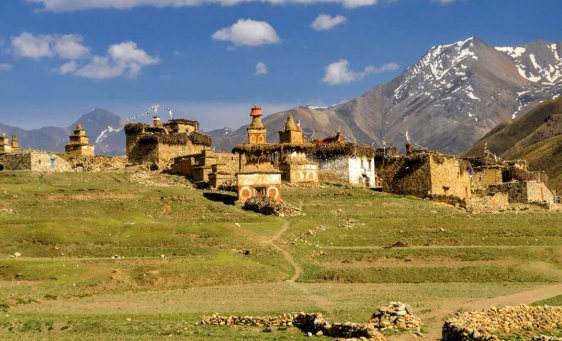The Upper Dolpo Trek is one of Nepal’s most remote and challenging trekking routes, offering a unique blend of rugged terrain, ancient Tibetan culture, and pristine natural beauty. Located in the far western region of Nepal, Upper Mustang Trek Dolpo is a hidden gem that attracts trekkers seeking an off-the-beaten-path adventure. This trek, which takes travelers through isolated villages, high-altitude passes, and Tibetan Buddhist monasteries, provides an authentic Himalayan experience far from the crowds of more popular trekking regions like Everest and Annapurna circuit trek
Trek Overview
The Upper Dolpo Trek is a strenuous journey that typically lasts 18 to 24 days, depending on the chosen itinerary. The trek begins in Juphal, which is accessible by a flight from Nepalgunj, a major city in the southwestern region of Nepal. From Juphal, trekkers head toward the remote valleys of Dolpo, passing through villages like Dunai, Tarakot, and Phoksundo. The trek reaches an altitude of up to 5,360 meters at the Numa La Pass, which presents a significant challenge for trekkers. The trek culminates at the stunning Phoksundo Lake, a sacred body of water that is surrounded by towering cliffs and deep forests.
Due to its remote location and lack of infrastructure, the trek requires trekkers to be in good physical condition and prepared for basic accommodations and facilities along the way. Most trekkers undertake this journey with a guide or porter, who is familiar with the route and can assist with logistics.
Scenic Beauty and Natural Wonders
The Upper Dolpo region is known for its dramatic Langtang valley Trek which range from lush green valleys to stark, arid terrain. The trek passes through alpine meadows, dense forests of juniper and pine, and rugged cliffs, all of which provide stunning backdrops for the journey. The diverse ecosystems and varying altitudes allow trekkers to witness the transition from subtropical to high-altitude landscapes, making each day on the trail a unique experience.

One of the most striking features of the trek is Phoksundo Lake, located in Shey Phoksundo National Park. This turquoise-blue lake, surrounded by snow-capped peaks, is a serene and mystical spot that holds spiritual significance for the local people. The area is home to various wildlife, including Himalayan blue sheep, musk deer, and several species of birds, making it a prime destination for nature lovers and photographers.
Another highlight of the trek is crossing the high-altitude passes like Numa La and Baga La, which offer sweeping views of the surrounding peaks and valleys. These passes are not only physically demanding but also provide trekkers with a sense of accomplishment as they reach the top and take in the panoramic vistas.
Cultural Exploration
The Upper Dolpo Trek is as much a cultural journey as it is a physical adventure. The region is home to the Dolpo people, an ethnic group with a strong Tibetan influence. The trek offers an opportunity to experience their traditional way of life, which has remained largely unchanged for centuries. The people of Upper Dolpo follow Tibetan Buddhism, and their culture is deeply intertwined with their spiritual beliefs.
Along the route, trekkers will pass through ancient villages and monasteries, where they can witness local customs, rituals, and the architecture of Tibetan-style stone houses. The region is dotted with Buddhist stupas, prayer flags, and mani walls, which are inscribed with sacred mantras. In addition, trekkers may visit several monasteries, including the famous Shey Gompa, which sits in a remote area and is known for its religious significance and stunning location.
Interacting with the local communities offers trekkers a chance to learn about the unique lifestyle of the Dolpo people, who live in harmony with the harsh environment. Their resilience, deep spiritual beliefs, and hospitality make the cultural experience of the Upper Dolpo Trek particularly enriching.
Acclimatization and Health Considerations
Given the high-altitude nature of the trek, acclimatization is crucial to avoid altitude sickness. The trek’s gradual ascent and the inclusion of rest days at strategic points allow trekkers to adjust to the altitude safely. However, it is important to note that the trek takes you through remote areas with limited access to medical facilities, so trekkers should be prepared for self-sufficiency and carry necessary medications.
Maintaining a steady pace, staying hydrated, and listening to your body’s signals are essential for a successful trek. It is also recommended to trek with an experienced guide who is familiar with the region and can ensure safety throughout the journey.
Permits and Logistics
To trek in the Upper Dolpo region, trekkers must obtain several permits, including the Shey Phoksundo National Park Permit and the TIMS (Trekkers’ Information Management System) card. These permits can be arranged in Kathmandu or through trekking agencies. The trek is not as accessible as other routes in Nepal, so it is advisable to organize the trek with a licensed agency that can assist with the logistics, including the necessary permits, guide, and porter services.
Conclusion
The Upper Dolpo Trek is a challenging yet rewarding journey for those seeking an off-the-beaten-path adventure in Nepal. With its rugged terrain, stunning landscapes, and rich Tibetan Buddhist culture, the trek offers a unique and immersive experience in one of the most remote regions of the Himalayas. For those willing to venture into this untouched corner of Nepal, the Upper Dolpo Trek promises an unforgettable adventure that combines physical challenge, cultural exploration, and the chance to experience some of the world’s most pristine natural beauty

